Let's discuss the types of Loaches. Loaches are freshwater fish that are popular in aquariums. They are bottom-dwellers, and most species grow about 6 inches long. Loaches are known for their playful personality and ability to get along with other fish.
There are more than 200 species of Loaches. These colorful fish come in a variety of shapes and sizes. Some Loaches have stripes, while others are solid-colored.
They belong to the Cobitidae family, which contains both Loaches and Carp. Loaches are found in Africa, Asia, and Europe. They inhabit streams, rivers, lakes, and ponds in the wild. These fish are commonly sold in pet stores and are prevalent in aquariums.
Some Loaches are diurnal, meaning they are active during the day. Others are nocturnal, meaning they are active at night.
Loaches are omnivorous and eat various foods, including pellets, flakes, live food, frozen food, and vegetables.
Most Loaches prefer to live in groups and do best when kept with at least six of their kind.
In this article, we will cover 9 different types of loaches and their lifespan, care, size, diet, and more.
Table of Contents
- Species Summary: Clown Loach
- Species Summary: Kuhli Loach
- Species Summary: Zebra Loach
- Species Summary: Hillstream Loach
- Species Summary: Horsehead Loach
- Species Summary: Yoyo Loach
- Species Summary: Dwarf Chain Loach
- Species Summary: Lepto Loach
- Species Summary: Weather Loach
- Choosing & Caring for Different Types Of Loaches
Species Summary: Clown Loach
| Scientific name: | Chromobotia macracanthus |
| Size: | 6 to 12 inches |
| Lifespan: | Up to 10 years |
| Temperament: | Peaceful |
| Color: | Orange with black stripes |
| Tank size: | 50 gallons or more |
| Water temperature: | 75°-81°Fahrenheit |
| Water type: | Freshwater |
| pH level: | 6.0-6.5 |
| Water hardness: | Soft to medium |
| Activity Level: | Moderate |
| Care Level: | Easy |
| Diet: | Omnivorous |
The Clown Loach is one of the most popular types of Loach. These fish are brightly colored and have playful personalities. They are peaceful fish that do well in community tanks.
They are native to Indonesia and can be found in rivers and streams. In the wild, these fish live in groups of up to 100. They are bottom-dwellers and prefer to hide in submerged vegetation or driftwood.
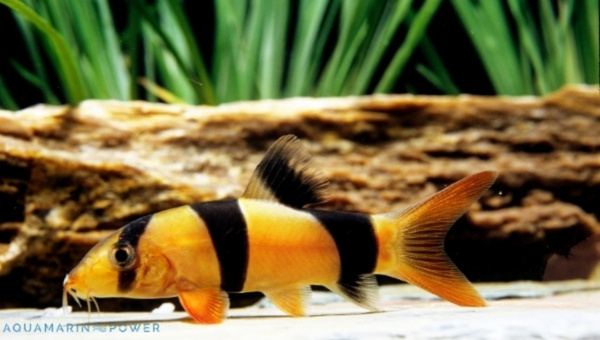
They are known for their orange color and black stripes. However, they can also be white or red. Clown Loaches grow to be about 6 to 12 inches long.
Their body is arched and compressed with protruding lower jaw. They have a single, continuous dorsal fin and an adipose fin.
Clown Loach: Food & Diet
Clown Loaches are omnivorous and eat various foods, including pellets, flakes, live food, frozen food, and vegetables.
In the wild, these fish feed on insect larvae, worms, crustaceans, and small molluscs. They should be given a variety of foods to prevent malnutrition.
Clown Loach: Tankmates
Clown Loaches are peaceful fish that do well in community tanks. They should be kept with other mild fish that are similar in size.
Good tankmates include neon tetras, barbs, gouramis, danios, and rasboras.
Clown Loach: Behavior
Clown Loaches are playful fish, and they are known for their social behavior. They often swim in groups and enjoy playing with each other.
These fish are also known for their comical antics. They have been known to play dead when they feel threatened.
Clown Loaches are diurnal, meaning they are active during the day. They should be given plenty of hiding places, as they like to hide when not involved.
Clown Loach: Breeding
Clown Loaches are challenging to breed in captivity. They have been known to reproduce in the wild, but this is rare.
If you are interested in breeding clown Loaches, it is best to consult a professional.
Species Summary: Kuhli Loach
| Scientific name: | Pangio kuhlii |
| Size: | 4 inches |
| Lifespan: | 10 to 14 years |
| Temperament: | Peaceful |
| Color: | Black, Pink, and Yellow |
| Tank size: | 15 to 20 gallons |
| Water temperature: | 75°-86°Fahrenheit |
| Water type: | Freshwater |
| pH level: | 5.5-6.5 |
| Water hardness: | Soft to medium |
| Activity Level: | Moderate |
| Care Level: | Moderate-Advanced |
| Diet: | Omnivorous |
The kuhli Loach is a popular type of Loach native to Southeast Asia. These fish are known for their long, slender bodies and unique patterns. They Look Like eels.
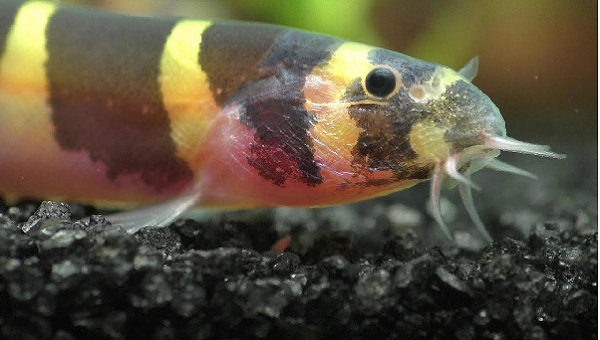
They grow to be about 4 inches long and have a lifespan of 10 years. Kuhli Loaches are peaceful fish that do well in community tanks. In the wild, these fish live in groups of up to 20.
They are bottom-dwellers and prefer to hide in submerged vegetation or driftwood. They are also known to burrow in the sand. They are black, pink, or yellow. They have unique patterns that resemble stripes or spots. These fish are timid and prefer to hide during the day.
Kuhli Loaches prefer small schools of three to six fish. They do not do well when they are kept alone.
Kuhli Loach: Food & Diet
They are omnivorous and eat various foods, including pellets, flakes, live food, frozen food, and vegetables.
These fish feed on small invertebrates in the wild, such as worms and crustaceans. They should be given a variety of foods to prevent malnutrition.
Kuhli Loach: Tankmates
Kuhli Loaches are peaceful fish that do well in community tanks. They should be kept with other peaceful fish that are similar in size.
Good tankmates include neon tetras, barbs, gouramis, danios, and rasboras.
Kuhli Loach: Behavior
Kuhli Loaches are shy fish that prefer to hide during the day. They should be given plenty of hiding places, such as caves and plants.
They are nocturnal, meaning they are most active at night. They are bottom-dwellers and prefer to hide in submerged vegetation or driftwood.
Kuhli Loach: Breeding
To breed kuhli Loaches, you must set up a breeding tank with soft, acidic water. These fish are difficult to breed in captivity, so it is best to consult a professional.
Also, check Cherry Barb Fish: Care, Tankmates, Lifespan, Breeding & All
Species Summary: Zebra Loach
| Scientific name: | Botia striata |
| Size: | 3-4 inches |
| Lifespan: | Up to 10-15 years |
| Temperament: | Peaceful |
| Color: | Yellow, Orange, and Brown bands |
| Tank size: | 20- 30 gallons |
| Water temperature: | 70°-79°Fahrenheit |
| Water type: | Freshwater |
| pH level: | 6.0–7.5 |
| Soft to the medium: | Soft to medium |
| Activity Level: | Moderate |
| Care Level: | Moderate |
| Diet: | Omnivorous |
The Zebra Loach is a popular type of Loach native to Southeast Asia. These fish are known for their orange and brown bands.
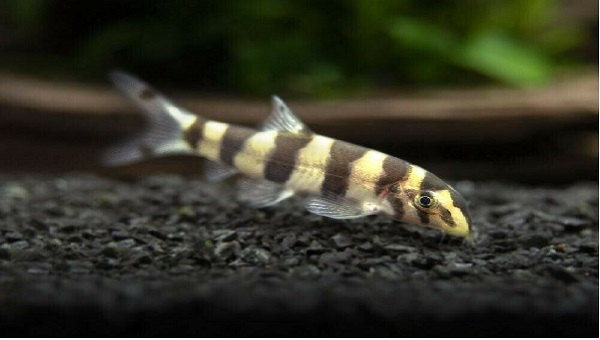
They grow to be about 4 inches long and have a lifespan of 10 years. Zebra Loaches are peaceful fish that do well in community tanks. In the wild, these fish live in groups of up to 20.
They are bottom-dwellers and prefer to hide in submerged vegetation or driftwood. They are also known to burrow in the sand.
Zebra Loaches prefer small schools of three to six fish. They do not do well when they are kept alone.
Zebra Loach: Food & Diet
The food & diet of the Zebra Loach is similar to that of the kuhli Loach. They are omnivorous and eat various foods, including pellets, flakes, live food, frozen food, and vegetables.
Zebra Loaches feed on wild bloodworms, mosquito larvae, and small crustaceans. They should be given a variety of foods to prevent malnutrition.
Zebra Loach: Tankmates
The tankmates should be peaceful fish that are similar in size. They should also be bottom-dwellers.
For Zebra Loaches, some good tank mates include neon tetras, barbs, gouramis, danios, and rasboras.
Zebra Loach: Behavior
Zebra Loaches are nocturnal bottom-dwellers that prefer to hide during the day. They should be given plenty of hiding places, such as caves and plants.
They scavenge the substrate for algae, worms, and small insects.
Zebra Loach: Breeding
Breeding them is complex and is best left to the experts. These fish lay their eggs in caves or among plants in the wild. The fry is born alive and can swim and feed on its own.
Also, check Plakat Betta Best Care Guide, Facts & Species Summary
Species Summary: Hillstream Loach
| Scientific name: | Sewellia lineolata |
| Size: | 2-3 inches |
| Lifespan: | 8 to 10 years |
| Temperament: | Peaceful |
| Color: | Yellow/light green, brown with white spots |
| Tank size: | 30 to 50 gallons |
| Water temperature: | 68°-75°Fahrenheit |
| Water type: | Freshwater |
| pH level: | 6.0–7.5 |
| Water hardness: | Soft to medium |
| Activity level: | Active |
| Care Level: | Moderate |
| Diet: | Omnivorous |
The hillstream Loach is a popular type of Loach that is native to East Asia. These fish are known for their yellow/light green and dark brown coloration.
With a dark brown body spotted with lighter colors, these Loaches have an attractive appearance that can add some flair to your aquarium.
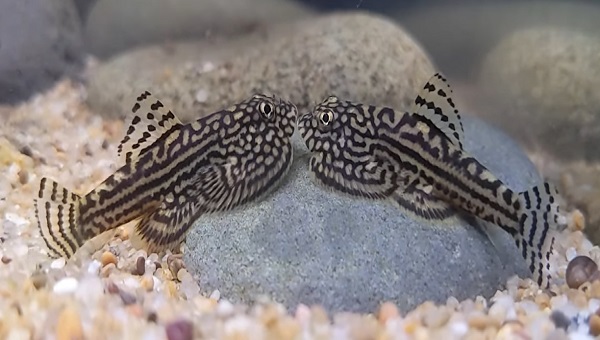
The hillstream Loach has a translucent underside with a black line running down the center. Powerful fins and a suckermouth help this Loach cling to rocks in fast-moving waters.
They grow to be about 3 inches long and have a lifespan of 8 to 10 years. Hillstream Loaches are peaceful fish that do well in community tanks.
In the wild, these fish live in fast-moving streams with rocky substrates. They use their suction cup-like mouths to attach themselves to rocks.
They prefer tanks with lots of hiding places and water movement. They should be kept in groups of at least six fish.
They prefer fast-flowing, well-oxygenated water. They are sensitive to poor water quality and should be kept in a tank with a filter.
A good filter for a hillstream Loach tank is a canister filter with a flow rate of at least 50 gallons per hour.
Hillstream Loach: Food & Diet
The food & diet of the hillstream Loach is similar to that of other Loaches. They are omnivorous and eat various foods, including pellets, flakes, live food, frozen food, and vegetables.
Hillstream Loaches feed on algae, small insects, and worms in the wild. They should be given a variety of foods to prevent malnutrition.
Hillstream Loach: Tankmates
They should be kept with other peaceful fish that are similar in size. They should also be kept with fish that prefer fast-flowing water.
Some good tank mates for hillstream Loaches include neon tetras, danios, rasboras, and gouramis.
Hillstream Loach: Behavior
Hillstream Loaches are active bottom-dwellers that prefer to hide among rocks and plants. They should be given plenty of hiding places.
They scavenge the substrate for algae, worms, and small insects.
Hillstream Loach: Breeding
While breeding hillstream Loaches in captivity is possible, it is best left to the experts. In the wild, these fish lay their eggs among rocks and plants. The fry is born alive and can swim and feed on its own.
You may also check Tiger Shovelnose Catfish 101: Best Detailed Guide
Species Summary: Horsehead Loach
| Scientific name: | Acantopsis dialuzona |
| Size: | 8 inches |
| Lifespan: | 7 to 10 years |
| Temperament: | Peaceful |
| Color: | Light bronze with brown dots |
| Tank size: | 20-50 gallons |
| Water temperature: | 75°-82°Fahrenheit |
| Water type: | Freshwater |
| pH level: | 6.0–6.5 |
| Water hardness: | Soft to medium |
| Activity level: | Active |
| Care level: | Moderate |
| Diet: | Omnivorous |
The Horsehead Loach is a prominent type of Loach native to Southeast Asia. These fish are known for their light bronze coloration with brown dots.
They grow to be about 12 inches long and have a lifespan of 7 to 10 years. Horsehead Loaches are peaceful fish that do well in community tanks.
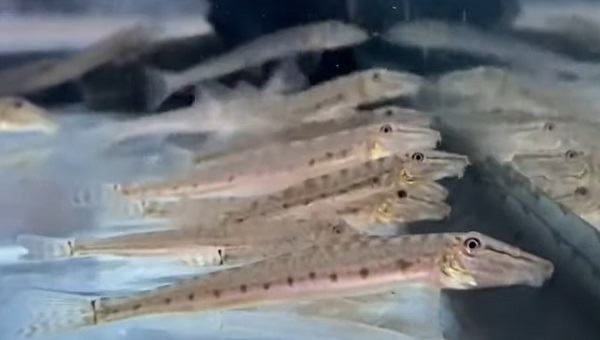
The Horsehead Loach has an elongated body with a flattened head. It has two barbels on its snout that resemble a horse's ears.
This Loach blends with the sandy substrate and is often mistaken for a dead leaf. It is an active bottom-dweller that scavenges the substrate for food.
These fish live in slow-moving rivers and streams with sandy substrates in the wild. They use their long barbels to find food in the substrate.
They prefer tanks with plenty of hiding places and a sandy substrate. They should be kept in groups of at least six fish. They prefer slow-moving, well-oxygenated water. They are sensitive to poor water quality and should be kept in a tank with a filter.
A good filter for a Horsehead Loach tank is a canister filter with a flow rate of at least 50 gallons per hour.
Horsehead Loach: Food & Diet
The Horsehead Loach feeds on pellets, flakes, live food, frozen food, and vegetables in aquariums. It feeds on insects, larvae, and small crustaceans in the wild.
The Horsehead Loach is a nocturnal feeder and should be given food at night. It may not eat during the day.
Horsehead Loach: Tankmates
The tank mates for horsehead Loaches should be peaceful fish that are similar in size. They should also be kept with fish that prefer slow-moving water.
Some good tank mates for horsehead Loaches include:
Neon Tetras, danios, rasboras, and gouramis.
Horsehead Loach: Behavior
Horsehead Loaches are active bottom-dwellers that prefer to hide among rocks and plants. They should be given plenty of hiding places. They scavenge the substrate for algae, worms, and small insects.
Keep one Horsehead Loach per tank, or they may become aggressive toward each other. Also, please do not keep them with fish that are smaller than they are.
Horsehead Loach: Breeding
The process of breeding Horsehead Loaches has not been perfected in captivity. In the wild, these fish lay their eggs among rocks and plants. The fry is born alive and can swim and feed on its own.
Species Summary: Yoyo Loach
| Scientific name: | Botia almorhae |
| Size: | upto 2.5 inches |
| Lifespan: | 5 to 8 years |
| Temperament: | Active, Friendly |
| Color: | Silver and dark brown |
| Tank size: | 20-40 gallons |
| Water temperature: | 75°-86°Fahrenheit |
| Water type: | Freshwater |
| pH level: | 6.0-7.6 |
| Water hardness: | Soft to medium |
| Activity level: | Active |
| Care Level: | Moderate |
| Diet: | Omnivorous |
The Yoyo Loach is a freshwater fish native to Bangladesh and Nepal. It gets its name from its habit of "yoyoing" up and down in the water column. These silverfish have dark brown stripes and can grow 2.5 inches long.
They have a 5 to 8 years lifespan and are known to be active and friendly fish. Yoyo Loaches do well in community tanks.
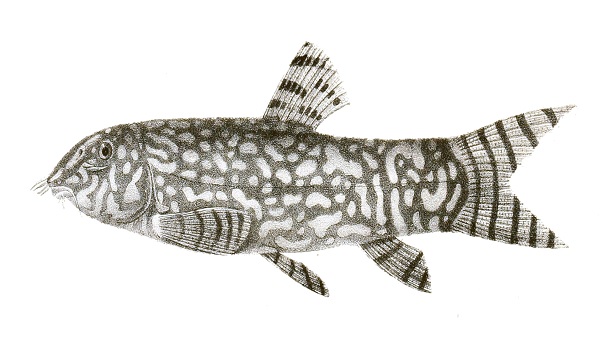
Adult yoyo Loaches have a more elongated body than juvenile fish. They also have three pairs of barbels on their snout. The head of an adult Loach is flat, and the body is compressed.
This Loach blends with the sandy substrate and is often mistaken for a dead leaf. It is an active bottom-dweller that scavenges the substrate for food.
These fish live in slow-moving rivers and streams with sandy substrates in the wild. They use their long barbels to find food in the substrate.
They prefer tanks with plenty of hiding places and a sandy substrate. They should be kept in groups of at least six fish. They prefer slow-moving, well-oxygenated water. They are sensitive to poor water quality and should be kept in a tank with a filter.
A good filter for a yoyo Loach tank is a canister filter with a flow rate of at least 50 gallons per hour.
Yoyo Loach: Food & Diet
The Yoyo Loach feeds on pellets, flakes, live food, frozen food, and vegetables in aquariums. It feeds on insects, larvae, and small crustaceans in the wild.
The Yoyo Loach is a nocturnal feeder and should be given food at night. It may not eat during the day.
Yoyo Loach: Tankmates
They are peaceful fish that are similar in size. They should also be kept with fish that prefer slow-moving water.
Some good tank mates for Yoyo Loachs include:
Neon tetras, danios, rasboras, and gouramis.
Yoyo Loach: Behavior
Yoyo Loaches are active bottom-dwellers that prefer to hide among rocks and plants. They should be given plenty of hiding places. They scavenge the substrate for algae, worms, and small insects.
Keep one Yoyo Loach per tank, or they may become aggressive toward each other. Also, please do not keep them with fish that are smaller than they are.
When adult Yoyo Loaches feed near the water's surface, they may "yoyo" up and down in the water column. This behavior is thought to be a way of dislodging food from the substrate.
Yoyo Loach: Breeding
You will need a tank with a sandy substrate and plenty of hiding places to breed Yoyo Loaches. The water should be well-oxygenated and kept at 75° to 86° Fahrenheit.
The female Yoyo Loach will lay her eggs in a hidden place, such as among plants or in a cave. The fry is born alive and can swim and feed on its own.
Species Summary: Dwarf Chain Loach
| Scientific name: | Ambastaia sidthimunki |
| Size: | 2 inches |
| Lifespan: | 8 to 12 years |
| Temperament: | Active, Semi-Aggressive |
| Color: | Golden brown, dark brown |
| Tank size: | 30 gallons |
| Water temperature: | 68°-86°Fahrenheit |
| Water type: | Freshwater |
| pH level: | 6.0-7.5 |
| Water hardness: | Soft to medium |
| Activity level: | Active |
| Care Level: | Moderate |
| Diet: | Omnivorous |
The dwarf chain Loach is a type of freshwater fish native to Thailand. It gets its name from the chain-like pattern of dark spots on its body. These fish are golden brown with dark brown spots and can grow 2 inches long.
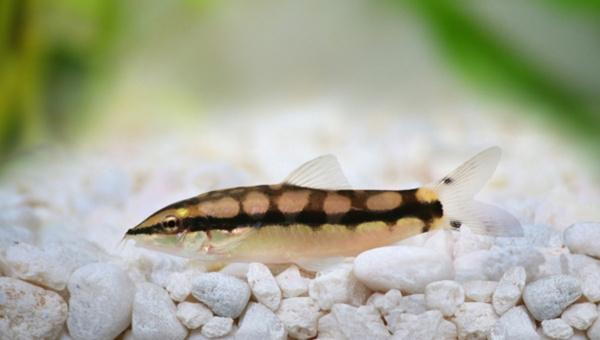
They have a lifespan of 8 to 12 years and are known to be active and semi-aggressive fish. Dwarf chain Loaches do well in community tanks.
The dwarf chain Loach is well-suited for life in fast-moving water with a thick, cylindrical body. It has a flat head with a pointed snout. Its mouth is located at the bottom of the snout and points downwards.
The chain Loach has four sets of thick barbels on its snout. These barbels are used to help the fish find food in the substrate.
This Loach blends with the sandy substrate and is often mistaken for a dead leaf. It is an active bottom-dweller that scavenges the substrate for food.
These fish live in slow-moving rivers and streams with sandy substrates in the wild. They use their long barbels to find food in the substrate.
They prefer tanks with plenty of hiding places and a sandy substrate. They should be kept in groups of at least six fish. They prefer slow-moving, well-oxygenated water. They are sensitive to poor water quality and should be kept in a tank with a filter.
Dwarf Chain Loach: Food & Diet
Because the dwarf chain Loach is a bottom-dweller, it should be given food that sinks to the bottom of the tank.
Some good foods for dwarf chain Loaches include pellets, flakes, live food, frozen food, and vegetables. In the wild, they mostly eat worms and small insects.
Dwarf Chain Loach: Tankmates
Dwarf chain Loaches are peaceful fish that do well in community tanks. They should be kept with fish that are similar in size and temperament.
Some good tank mates for dwarf chain Loaches include danios, neon tetras, rasboras, gouramis, and catfish.
Dwarf Chain Loach: Behavior
Dwarf chain Loaches are active bottom-dwellers that prefer to hide among plants and rocks. They should be given plenty of hiding places.
With a semi-aggressive temperament, these fish may become aggressive toward each other if they are not kept in groups. They are also known to eat smaller fish.
They are considered aggressive, and their playful nature makes them fun to watch. Keeping larger groups will also help to reduce aggression.
Also, check Ultimate Dragon Goby 101: Care, Appearance, Food, Habitat & All.
Dwarf Chain Loach: Breeding
In the wild, dwarf chain Loaches breed during the rainy season. The female Loach will lay eggs in a hidden place, such as among plants or in a cave. The fry is born alive and can swim and feed on its own.
To breed dwarf chain Loaches, you need a tank with a sandy substrate and plenty of hiding places. The water should be well-oxygenated and kept at 73° to 82°Fahrenheit.
Species Summary: Lepto Loach
| Scientific name: | Leptobotia elongata |
| Size: | 1.6 feet |
| Lifespan: | 5 to 8 years |
| Temperament: | Aggressive |
| Color: | Golden brown with dark brown |
| Tank size: | 20 gallons |
| Water temperature: | 72°-77°Fahrenheit |
| Water type: | Freshwater |
| pH level: | 6.0-7.5 |
| Water hardness: | Soft to medium |
| Activity level: | Active |
| Care Level: | Moderate |
| Diet: | Omnivorous |
The Lepto Loach is a type of freshwater fish native to China. It gets its name from the Greek word "leptos," which means "slender." These fish are golden brown with dark brown spots and can grow 12 inches long.
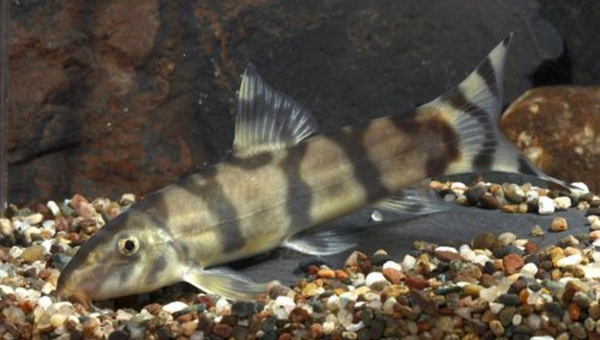
They have a lifespan of 5 to 8 years and are known to be aggressive fish. Lepto Loaches do well in community tanks.
This Loach blends with the sandy substrate and is often mistaken for a dead leaf. It is an active bottom-dweller that scavenges the substrate for food.
These fish live in slow-moving rivers and streams with sandy substrates in the wild. They use their long barbels to find food in the substrate.
They prefer tanks with plenty of hiding places and a sandy substrate. They should be kept in groups of at least six fish. They prefer slow-moving, well-oxygenated water. They are sensitive to poor water quality and should be kept in a tank with a filter.
Lepto Loach: Food & Diet
Lepto Loaches are bottom-dwellers who prefer food that sinks to the bottom of the tank. Some good foods for Lepto Loaches include pellets, flakes, live food, frozen food, and vegetables. They are also known to eat small insects.
Lepto Loach: Tankmates
Lepto Loaches are peaceful fish that do well in community tanks. They should be kept with fish that are similar in size and temperament. Some good tank mates for lepto Loaches include danios, neon tetras, rasboras, gouramis, and catfish.
Lepto Loach: Behavior
Lepto Loaches are some of the most aggressive Loaches. They are known to attack and eat smaller fish. They should be kept in groups of at least six fish.
Lepto Loaches are active bottom-dwellers that prefer to hide among plants and rocks. They should be given plenty of hiding places. This Loach is known for fin nibbling and may damage the fins of other fish.
Because lepto Loaches are more active at night, they are often seen swimming in the middle of the tank during the day. They are also known to jump out of the tank, so a lid is necessary.
Lepto Loach: Breeding
Breeding lepto Loaches is complex and has only been done in captivity a few times. These fish are not sexually dimorphic, so it is hard to tell the difference between males and females.
To breed lepto Loaches, you will need a tank with a sandy substrate and plenty of hiding places. The water should be well-oxygenated and kept at 72-77 degrees Fahrenheit.
The female Loach will lay eggs in a hidden place, such as among plants or in a cave. The fry is born alive/ and can swim and feed independently.
Species Summary: Weather Loach
| Scientific name: | Misgurnus anguillicaudatus |
| Size: | 6 to 12 inches |
| Origin: | East Asia |
| Common Name: | Dojo Loach, Oriental Waterloach, oriental weatherfish. |
| Lifespan: | 7 to 10 years |
| Temperament: | Peaceful |
| Color: | Green bronze with brown spots forming bands |
| Tank size: | 20-50 gallons |
| Water temperature: | 64°-75°Fahrenheit |
| Water type: | Freshwater |
| pH level: | 6.0-8.5 |
| Water hardness: | Soft to medium |
| Activity level: | Active |
| Care Level: | Easy |
| Diet: | Omnivorous |
The Weather Loach, or dojo Loach, is native to Siberia, Japan, Korea, China, and Taiwan. It gets its name from its ability to predict the weather. These fish are green bronze with brown spots that form bands. They can grow 12 inches long and have 7 to 10 years of life.
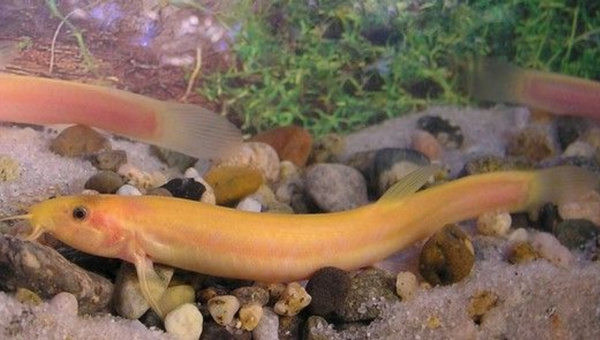
Weather Loaches have elongated, eel-like bodies and long barbels on their mouths. They are bottom-dwellers that prefer to hide among plants and rocks. These fish live in rivers and streams with sandy substrates in the wild.
Weather Loaches have downturned mouths and long barbels to find food in the substrate. They should be given a variety of foods to keep them healthy.
They are peaceful fish that do well in community tanks. They should be kept in groups of at least four fish. Weather Loaches prefer slow-moving, well-oxygenated water. They are sensitive to poor water quality and should be kept in a tank with a filter.
Weather Loach: Food & Diet
Weather Loaches are omnivorous and will eat most types of aquarium food. Some good foods for weather Loaches include pellets, flakes, live food, frozen food, and vegetables.
Weather Loach: Tankmates
Weather Loaches are peaceful fish that do well in community tanks. They should be kept with fish that are similar in size and temperament. Some good tank mates for weather Loaches include danios, neon tetras, rasboras, gouramis, and catfish.
Weather Loach: Breeding
The process of breeding weather Loaches has not been perfected in captivity. These fish are not sexually dimorphic, so it is hard to tell the difference between males and females.
You will need a tank with a sandy substrate and plenty of hiding places to breed weather Loaches. The water should be well-oxygenated and kept at 72-77 degrees Fahrenheit.
The female Loach will lay eggs in a hidden place, such as among plants or in a cave. The fry is born alive and can swim and feed on its own.
Dojo Loaches are exciting to fish that are easy to care for. They make a great addition to any community tank.
Choosing & Caring for Different Types Of Loaches
In an aquarium, there are many different Loach species to choose from. The most popular Loaches include Clown, Weather, and Dojo Loach.
When choosing a Loach, it is essential to consider the fish and your tank's size. It is also necessary to consider the temperament of the fish and whether or not it will do well with other fish in your tank.
Once you have chosen a Loach, providing the fish with a good home is essential. Loaches prefer tanks with plenty of hiding places and a sandy substrate.
Loaches are exciting to fish that are easy to care for. They make a great addition to any community tank.
A Loach might be the perfect fish if you are looking for an exciting and active bottom-dweller!



